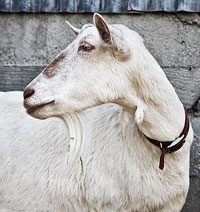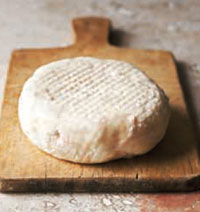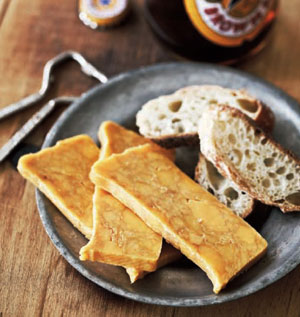CHEESE MAKERS' FORMULAS & TIPS
In this section, stories, formulas, and tips from notable cheese makers are shared for your enjoyment and education.
Peter Dixon: Lactic type Goat Cheese
Goat Experience:
A Lactic Type goat cheese of France, which Consider Bardwell Farm’s Experience is modeled after.
The recipe for The Goat Experience, which appears in Artisan Cheese Making at Home, was contributed by Peter Dixon,
the extraordinary, award-winning cheese maker at Consider Bardwell Farm in Vermont. His knowledge and skills are
renowned in the American artisan cheese world. I’m honored to have the opportunity to share his work with you.
In the book, we present this recipe in a more simplified version, configured to be easily read and followed by
the hobbyist cheese maker, in the format of the other cheese making formulas. In that version, some of the cheese
maker's voice as an educator is missing. For that reason, I present to you the submission as it came from Peter Dixon,
in his voice. I have numbered the key steps for you to follow more easily. I hope you will enjoy the read.
Click here for recipe
|
 |
From Peter: Aged soft-ripened lactic goat cheeses comprise a very large and diverse group of cheeses that originate in
France. They can be served after only ten days of ripening or aged to the extent where they turn into hard grating cheeses.
They vary widely in appearance and shape but are all relatively small, weighing from 2 to 12 ounces. The most typical lactic
goat cheeses of France are St. Maure, a log shaped bloomy, Valencay, a pyramid rolled in ashes after salting with a natural
mold rind; Chabichou, a small cone with natural crust; Crottin de Chavignol, a puck with natural crust.
Recipe: Curd Preparation, in Peter’s words: The curd is characterized by having both rennet and lactic qualities because
small amounts of rennet are used and a high level of acidity is developed before the curd can be ladled into the forms to
begin the draining of whey. The curd is formed in the vat during a period of 15 to 28 hours depending on the cheesemaker's
schedule. Because of their short aging period, these cheeses are made from pasteurized milk.
Cheese molds: 4 Crottin molds
Ingredients:
2 gallons pasteurized goat’s milk
MM 100 in quantities listed below
Or
MA 011 or MA 014 in quantities listed below
1 ml calcium chloride, diluted
1 ml single strength liquid rennet, diluted
Kosher salt
The curd is made in the following manner:
Steps:
- 2 gallons pasteurized goat’s milk gently heated at 68-75 °F.
- Add starter culture: Use a mesophilic lactic or mesophilic aromatic direct-vat-set culture.
MA series or MM series cultures are used. The MA series makes a tangy lactic curd and the MM series provides additional
aromatic flavor from the L. diacetylactis bacteria, which is added to the blend. These cultures can be purchased from
Glengarry Cheesemaking Supplies or the Dairy Connection (see Resources)
The cultures are added to two gallons of milk in the following amounts based on the time to wait before ladling curds.
The temperature is also adjusted.
15-20 hours: 1/8 tsp. 75 °F
20-28 hours: 1/16 tsp. 72 °F
- Mix the culture in for 5 minutes. Wait 25 more minutes for milk to acidify.
- Add 1 ml calcium chloride solution diluted in a half cup of water to promote curd firming. Stir the calcium chloride in
for one minute.
- Add 1 ml single-strength rennet directly to the two gallons of milk and stir it in for twenty seconds.
- Ripen the milk for 15-28 hours until the acidity of the whey is at least the pH 4.60 and and not lower than pH 4.40.
If you do not have a way to measure the acidity that develops during the fermentation then the signs that the curd is
ready to ladle are that it has separated from the sides of the vat and there is a half inch layer of whey on top and there
are usually cracks in the curd body. The temperature should have held steady throughout the night.
- The curd can be ladled in large scoops and drained in cheesecloth for 10-15 hours and then packed into crottin forms or
gently ladled in small scoops directly into the forms.
- The extent of draining and the temperature of the room determine how much whey is removed from the curd. The draining
period regulates the body characteristics and determines the final quality of the cheese. This period can be from 15-36
hours at a temperature of 68-72 °F. Higher temperatures promote gas formation and excessive moisture loss; lower
temperatures inhibit whey drainage.
- Two hours after the end of packing from the cloth or direct ladling sprinkle a quarter teaspoon of kosher salt on the
top of each curd in its form.
- Day Three: In the morning the cheeses can be turned and returned to the forms. Another quarter teaspoon of salt is
sprinkled on top. The cheeses are left until the late afternoon.
- Drying the Cheeses
After draining is finished, the cheeses are removed from the forms and placed on drain matting set on open air shelving
in a 60-65 °F (usually air-conditioned) room with a ventilation fan to move air over the cheeses.
Penicillium mold and other mixtures may be sprayed onto the cheese at this point.
It is best to use a solution with a dash of CHOOZIT CUM yeast, a dash of Geo 17 mold and a pinch of Penicillium
candidum mold added to a quart of distilled water. Prepare this the day that you are ladling curds.
This solution will work for two weeks if kept in the refrigerator.
Alternatively these cultures can be added to the milk (MK: in step just after starters are added).
The yeast and molds should grow in just as well with either method.
- Aging the Cheeses
The cheeses should be turned over the next day and then left until there is visible mold growth on the surface.
This should take three to five days. When there is growth, turn the cheeses over and move them to a more humid
and colder place. This should be 45-48 °F and 90% relative humidity with a gentle air flow over the cheeses.
Turn the cheeses every day until they are completely covered with white mold. This should happen within ten days
from spraying the cheeses.
Many cheesemakers keep the cheeses in covered plastic containers in a refrigerator so that there will be enough humidity.
The top can be cracked to let in air if there is condensation. In this way the cheeses can age for several weeks.
It is a good idea to turn the cheeses and rub the mold down periodically to prevent the rind from getting too thick.
The cheeses are generally ready to eat in two to three weeks and can be ripened longer for stronger flavor.
The best packaging is a breathable wrapper made of plastic and wax paper or cellophane and wax paper.
These can be purchased from Glengarry Cheesemaking Supplies.
Resources: There are two books that are very helpful in learning to make these cheeses.
French Cheeses by Masui and Yamada is great for visual images and some make procedures.
The Fabrication of Farmstead Goat Cheese by La Jaouen is the essential text.
Copyright Peter Dixon 2009 | Contact:
peterhicksdixon@gmail.com,
www.dairyfoodconsulting.com
As submitted to
Artisan Cheese Making at Home
Close.
Jim Wallace: Comparison of Epoisses and Robiola with fresh and bloomy version
The recipes for Epoisses, and Bloomy Robiola, which appear in Artisan Cheese Making at Home, were contributed by
Jim Wallace, a passionate cheese maker and notable cheese making consultant. I contributed the Leaf-wrapped Fresh Robiola
version based on guidance from Jim.
Because these cheeses are benchmarks to many in the cheese-loving world, I wanted to present them both, Epoisses
(the glorious, quintessential French ‘stinker’) and Robiola (the delicate, slightly bloomy Italian relative) to hobbyist
cheese makers as cheeses we could learn to make. I did outreach to Jim and he thankfully, took on the challenge so that
they could be formulated and presented to you. The full recipes are in the book. Those versions have been formatted and
edited to be easy to follow for those less familiar with making extended lactic coagulation cheeses. More importantly,
there just wasn’t room in the book to present all that Jim had to say about these two cheeses and how they are related.
So, here you have the entire submission as was presented to me, in Jim's voice.
Click here for recipe
|
 |
From Jim: These are very similar cheeses in the make process but vary considerably in the ripening. They come from 2 very different
areas, Burgundy in France and Piedmont in Italy (very near Bra, the home of SlowFoods). Epoisses is a cow’s milk cheese
whereas Robiola was traditionally an all goat milk cheese.
They are both lactic coagulations (as opposed to rennet coagulation).
In the lactic process little to no rennet (perhaps 1-2 drops per gallon of milk) is used and the coagulation takes a much
longer time, usually 12 -24 hours. This can be from natural bacteria in the milk or from modern lab prepared cultures.
Eventually the acid increases to a pH of 5.1 where the milk begins to coagulate into a curd and on to 4.6-4.8 where a
solid curd is formed. The curd formed is very weak and only small cheeses can be made this way and a rather short aging
period.
Other examples of this would be Chevre, Chaorce, St Marcellin, etc.
Epoisses comes from the Burgundy area of France:
The milk is heated to around 86°F and the coagulation lasts for 16-20 hours. At this point the curd is extremely soft
and transferred to molds for draining for 48 hours at 68-72F.
Following this the cheese is dry salted and placed on racks to dry. When dry, they are moved to cellars for maturing.
This is a washed rind cheese and at this point the cheese is rinsed every 3-4 days in a mixture of water and marc
(the distilled product from pressed wine skins). The quantity of the marc is increased as the process continues.
The cheese is brushed to evenly spread the bacteria over the surface. The key here is to maintain a moist but not
excessively wet surface (herein lies the challenge). The yeast and many other ferments undergo a progressive development
which eventually produces the very aromatic and colorful surface.
The exterior should produce a very pungent pink to orange surface and the interior of the cheese will become very
soft and creamy at about six weeks. This cheese has a very short shelf life and will not endear you to the close
community on a hot summer’s day. In France I am told that it is the only cheese not allowed to be taken on public
transportation.
Robiola comes from the Piedmont area of Italy:
For Robiola however the EU standards have watered down the requirements and it can be made up of a good portion of cow’s
milk. You will see this on the counter as "due" and "tre" latte versions incorporating cow, ewe, and goat milk.
The traditional Robiola di Roccaverano style was from a special breed of goat in that region.
Stracchino is a term used to describe a rather large group of fresh cheeses. It came from moving the cows to and
from higher pastures and simply means the "tired" animals. They felt that this was a richer milk from the moving herd.
The mixed raw milk is set at 95°F and a natural (from the animal) or prepared (DVI) lactic ferment begins.
Rennet additions will vary from none to 6-8 drops per gallon. The curd forms in 12-18 hours and is then ladled into
forms placed on draining mats. When the cheese shows a clear whey draining, it is placed in a conditioned space at
approximately 77°F with a high humidity of 92-95%. At 30-48 hours the cheese will be moved to a cooler storage but
with the same high moisture.
After approximately 10 hours the forms are either dry salted or brined. The aging (stagionatura) of the robiola can
be of 7-10 days, or to a prolonged aging of several weeks to develop some character.
Bloomy Robiola:
In the case of developing a longer ripened cheese a small amount of geotrichum (1/16tsp per gallon) can be added to
the milk before rennet. This along with ambient yeast from the surrounding environs will begin to form a very thin
skin around the cheese and the interior will begin to soften due to the enzymes this surface provides. The surface will
begin with a white-cream surface and may develop into a slight rosy blush and at 3-4 weeks this may develop some surface
blue and other character. At this point the cheese is very ripe and will barely be contained by the thin skin that has
formed.
Copyright Jim Wallace 2009 | Contact:
jim@cheesemaking.com
As submitted to
Artisan Cheese Making at Home
Close.
More Cheese
More cheese making formulas:
Click Here


